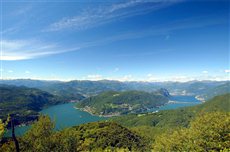Mount San Giorgio
In Valceresio, a few miles northeast of Varese, UNESCO recognized as a UNESCO Natural World Heritage the paleontological district of Monte San Giorgio, especially rich of marine vertebrate fossils of the Middle Triassic, around 240 million years ago. The reputation of the Monte San Giorgio is due to the presence of several fossiliferous levels covering over 10 million years yielding more than 80 species of fishes, 30 reptiles as well as mussels, crustaceans, insects and plants. UNESCO site is transnational, divided between Italy and Switzerland, but its uniqueness is given by the geology and fossils... that do not require passport.
The Besano fossils
An area of important historical and environmental quality is given even greater interest by the presence of layers of fossiliferous rock dating to the Mesozoic Era.
The finding of a fossil of an aquatic reptile that lived in the Triassic epoch, dating to about 235 million years ago, in the municipal territory of Besano, is something that happened only a few years ago. This remarkable fossil creature was named the Besanosaurus, and it is not the only important fossil to have been uncovered in this area of Valceresio. In fact, many other fossils have been found in the fossiliferous strata in the area between Besano and Monte San Giorgio, in Switzerland. The latter peak had been famous for its fossils right from the 19th century.
The town of Besano has a civic museum whose exhibits include pieces from this remarkable historical and environmental heritage, amongst which fossil fish, marine and terrestrial reptiles, plants and invertebrates, from the Mesozoic age and more specifically from the Middle Triassic period. In that epoch, these areas were part of a vast ocean called Tethys. The drying and disappearance of the ocean coincided with the formation of the Alpine chain.
Tintorina the triassic 'Mosquito'
Monte San Giorgio has been known since 170 years for its fish and reptile fossils. Some of them are very large, for example the ichthyosaur Besanosaurus, a marine reptile with a dolphin-like shape, 6 meters long. Some other, though small, show an astonishing preservation, like "Tintorina", found on the Swiss side of the mountain. Its wings are perfectly preserved: the wing ribs are still visible and so are even traces of color, though we cannot say today what color it was. On the other hand, 230 million years have passed since the time this insect used to flutter over one of the islets dotting the tropical coastal lagoon bound to become the Monte San Giorgio!
The Besano fossils
The finding of a fossil of an aquatic reptile that lived in the Triassic epoch, dating to about 235 million years ago, in the municipal territory of Besano, is something that happened only a few years ago. This remarkable fossil creature was named the Besanosaurus, and it is not the only important fossil to have been uncovered in this area of Valceresio. In fact, many other fossils have been found in the fossiliferous strata in the area between Besano and Monte San Giorgio, in Switzerland. The latter peak had been famous for its fossils right from the 19th century.
The town of Besano has a civic museum whose exhibits include pieces from this remarkable historical and environmental heritage, amongst which fossil fish, marine and terrestrial reptiles, plants and invertebrates, from the Mesozoic age and more specifically from the Middle Triassic period. In that epoch, these areas were part of a vast ocean called Tethys. The drying and disappearance of the ocean coincided with the formation of the Alpine chain.
Tintorina the triassic 'Mosquito'





